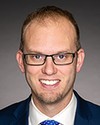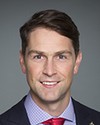Good afternoon, everyone, and thank you for giving us the opportunity to act as witnesses and make a presentation to the Standing Committee on Indigenous and Northern Affairs.
First off, I'd like to introduce myself. I'm Councillor Keith Grier, chair of Aakom Kiyii Health Services advisory committee. To my left, I have our health director, Dustin Wolfe, and to my right, I have council member and advisory committee member Troy Knowlton.
I'd like to say thank you on behalf of chief and council, Aakom Kiyii Health Services, the Piikani Nation membership and our elders for giving us this opportunity. It is a great privilege and an honour to be heard by your committee and to speak on behalf of our elder continuing care facility.
I'd like to give you a little bit of background and our geographical location. The Piikani Nation is a proud member of the Blackfoot Confederacy and Treaty 7, which is composed of four member nations. The Blackfoot Nation is located in Montana, U.S.A. The remaining three sister tribes, the Kainai, Siksika and us, the Piikani, are located in southern Alberta. In total, we comprise approximately 45,000 Blackfoot members.
The Piikani Nation, along with all the member nations I mentioned, are on a journey to reclaim and preserve the Blackfoot language and practise traditional and spiritual values and norms that are consistent with the Blackfoot customs.
The Piikani Nation is a population of approximately 3,700 registered members, of which 2,500 members live on the reserve. The Piikani Nation is located west of the town of Fort Macleod in southern Alberta, and east of the town of Pincher Creek.
The Piikani Nation is a proud and productive growing community, and we have a diverse range of health care needs. Aakom Kiyii Health Services, AKHS, exists to serve these health needs and has done so for many years through our contribution agreements with the federal government.
With our population rapidly growing, with young families, young people and rapidly aging older members presenting increasing rates of multimorbidity, our nation wants to be proactive and future-oriented in our approach toward health care. To address these population trends, our nation wishes to pursue planning for a better future for our elders living in the community through developing an accredited, on-reserve elderly continuing care facility. In pursuing this initiative, the Piikani Nation wishes to build a 40-bed large care centre for the nation's elders, on reserve for proximity to family members and on traditional lands.
The Piikani Nation also wishes to design and deliver a continuing care program that's Piikani-centric, while meeting the standards of care defined by the Alberta Health Services, AHS. In doing so, we would incorporate Blackfoot traditional practices and language, employ Piikani Nation members, integrate into other departments and programs in the community, maintain an AHS long-term agreement, and hopefully develop a tri-party agreement among the federal, provincial and the Piikani Nation governments.
Currently, Aakom Kiyii Health Services provides a variety of primary care, community care, home care and preventive services. However, elders require supportive care, long-term care, respite and restorative care, and palliative care, as we know.
Currently, we do not have a facility on the reserve, and those requiring those services must access AHS-funded facilities in Lethbridge, Fort Macleod and Pincher Creek. Unfortunately, the situation separates nation members from families, traditional lands and practitioners who are familiar with the Blackfoot language, traditions and customs.
We are in a time of truth and reconciliation with the federal government, provincial government and first nations across Canada. It must be understood that a lot of these health issues are a direct result of extreme stress and the poor socio-economic status of first nation people, and they have a long-term negative effect on some first nation people across Canada. The Piikani Nation is no exception.
The extreme stress I speak of is poor federal government policies that were introduced and are well known to first nations people across Canada as the residential school era, where, as you know, for 140 years children were legally and forcefully taken away from their way of life, their parents, everybody they loved and everything they knew, and introduced into a Eurocentric world view.
The Health Council of Canada report also indicates that the lasting effects of residential schools have been described as a form of post-traumatic stress disorder. Many first nation elders delay seeing health care practitioners and professionals regarding their symptoms until they are seriously ill, as they are afraid their diagnosis would mean that they would be sent away and never returned home.
The proposed Piikani Nation continuing care facility would put elders with trusted, skilled and locally trained professionals, assuring them that their health concerns would be raised in a safe environment. Under the first nations transformation agenda, first nations, the federal government and provincial governments have identified reconciliation of health outcomes that exist for first nation communities as a priority.
I believe an elderly care facility would assist in filling those gaps by providing a safe and culturally appropriate environment to grow old in, improved health care for our elderly, and familiar surroundings, culture, language and relatives leading to a richer patient experience. It would provide a learning space where Piikani professionals, researchers and AHS officials can share ideas, develop new approaches and test innovative practices for other indigenous communities. It would expose Piikani youth to various health care careers, as well as provide opportunities for language, culture and tradition to be shared and passed down from the elders before it's too late, as well as opportunities for family members to visit more frequently.
The proposed facility would be one step in addressing an unacceptable statistic highlighted here by our nation, ownership in our own community over elder care and ensuring opportunities identified by our nation.
The Piikani Nation would have to comply with the specific mandatory requirements and standards that govern both accommodation and health services for continuing care. These requirements are in place to ensure accommodations maintain a high level of service, i.e., meal preparation, building maintenance, security and housekeeping, which promotes safety and security and a better quality of life. We will work and consult on an ongoing basis with Alberta Health Services to ensure a proper level of care and services will be offered, and how the facility would be staffed with respect to the number and type of health care and support staff.
On page 25 of the feasibility study that we have shared with you, operating expenses associated with a large 40-bed facility were estimated based on actual operating expenses obtained by Meyers Norris Penny, one of our partners, for an existing large elder care facility operating in Ontario. The cost to operate the facility in a centralized building concept is $617,253 annually.
We've looked at the capital costs that need to be laid out for this facility. The construction and site development for a large facility would require considerable investments—we know that. However, we feel that with the current population trends and the health issues that exist with our elderly it is justifiable. The actual cost of construction would be determined after final drawings, fit-ups and construction firms are chosen. A table is provided on page 24 of our feasibility study, and the cost would be $11,419,002.
We have partnered with the Good Samaritan Society. We have also partnered with AHS, which is Alberta Health Services, and we've partnered with MNP.
In closing, the Piikani Nation, in conjunction with Aakom Kiyii Health Services and our partnerships, have been committed to developing and establishing an accredited 40-bed elderly care facility to provide an overall richer experience, and one rooted in Blackfoot customs.
I'd like to thank the standing committee for hearing us and listening to us, and reviewing our feasibility study. Thank you for your time.




